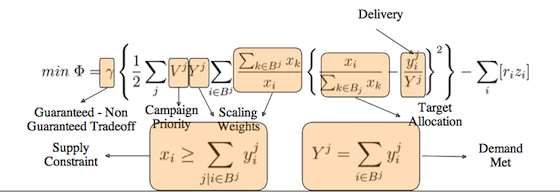Yesterday, the New York Times ran a front-page story on retargeting--the practice of stealthily tracking an individual user online in order to keep delivering sales pitches–including for health and financial products. We gave the NYT lots of information, including how so-called “smart” ads technologies are now melded with retargeting–for so-called “Retargeting 3.0.“ [My CDD and USPIRG, btw, asked the FTC to investigate retargeting back in 2007 and to protect consumers]. Here’s some of what we sent to the Times.
From Criteo:“Retargeting allows you to find your previous website visitors across the Internet and display relevant banners to lead them back to your website to complete their transaction. Bringing ready-to-buy users back to your website after they have left should be a key part of your customer acquisition and conversion strategy. Criteo provides a breakthrough dynamic personalised retargeting solution…Criteo has revolutionised retargeting with the most sophisticated form of dynamic personalised retargeting. Over the past decade there has been a slow evolution of retargeting. This third generation of retargeting enables an advertiser to show each lost visitor a unique banner based on his/her very specific past interactions on the advertiser’s website. This new form of retargeting involves on-the-fly, real-time personalised banner creation and has a dramatic impact on campaign performance.”
Retargeting data now incorporates user information from outside demand side platform sources, and can the rights to retargeting you can be sold to the highest bidder via online ad exchanges, such as the one run by Google.
A recent MediaPost panel sums up how retargeting has evolved:
Re-Thinking Re-TargetingÂ
Re-targeting continues to be the tried and true workhorse of behavioral targeting. Tagging and retrieving someone who has already shown an interest in your business is about as simple a use of the BT model as it gets. But it is not so simple any more, and like everything else in this complex ad economy, re-targeting too is in for a upgrade. Dynamic ad creation driven by recommendation engines offers new opportunities to marketers to be even more effective. Demands for greater accountability, control over placement and clearer attribution press the ad networks and tech providers to provide new levels of transparency. And just like everyone else in the ad economy, re-targeting is working its way through questions about metrics and pricing, do marketers optimize and pay according to clicks, conversions, purchase? And what role does retargeting now play in this larger field of audience creation and the age of the DSP?
Retargeting illustrates how online marketers have deployed armies of digital private detectives to shadow us online. They watch us closely, take notes, even learn about us, and then appear when we don’t expect it. Consumers shouldn’t have to confront such digital surveillance. Retargeting is “Exhibit A” in making the case to lawmakers that consumer privacy online should be protected.
Questions should also be raised about retargeting and consumer protection. Should I get a better discount because the data collected about me indicates I spend more or live in an expensive neighborhood? Or that because they believe I am a certain ethnicity, I might spend more on certain products. Retargeting is a non-transparent marketing technique that raises important consumer protection issues about the use of digital advertising. Consumers require a fair deal online.
PS:Â Here’s how Google explains its retargeting service–which in typical Silicon Valley meets George Orwell fashion, it calls “remarketing’ [for the Google Content Network]: “Remarketing is extremely effective because it targets a highly-relevant audience. With it, you can target users who:
- have visited your website or viewed specific product categories on your site
- didn’t convert or who abandoned their shopping cart
- have converted (in order to up- or cross-sell to them)
If you’re already driving traffic to your site through other means, like contextual targeting or your search ads, remarketing is a great complement to those efforts to increase your return-on-investment (ROI).”
and we believe in fair play. Here’s what Microsoft says its “remessaging” service can do:  “After consumers visit your site, see one of your campaigns or click through on an ad, remessaging offers several ways to continue the conversation and ensure that your message is seen by the people to whom it matters most. With site remessaging, you can re-engage a consumer to complete a purchase or further engage with your brand. Creative remessaging drives brand perception, awareness, and favorability, and enables advertisers to re-engage audiences who have seen or clicked on an existing campaign. Email remessaging complements email assets such as newsletters by placing tags and accessing the same email recipients to reinforce your message to a loyal audience.”
and Yahoo!: “…Enhanced Retargeting, which combines standard site retargeting with dynamic ad generation. For example, users who visit an airline website to check offers for flights from SFO-JFK can be served a personalized offer for that specific flight when they visit a page within the Yahoo! Network. In a recent trial, a market-leading online travel company saw a 230% increase in total bookings and a 651% increase in click-through rate when comparing Enhanced Retargeting to their traditional retargeting campaign. Recognizing the need for more focused audience segmentation and improved control, Yahoo! Search Marketing will offer advertisers Enhanced Targeting capabilities for Sponsored Search and Content Match programs. New features are designed to extend the advertiser’s control over where and when an ad is shown at both the campaign and ad group level, including what time of day and day of the week an advertiser would like campaigns to run (ad scheduling) and what age and gender they’d like to reach (demographic). Advertisers will be able to vary their bids for different segments in order to increase their ability to reach the desired audience.”
 That’s the formula Yahoo is using to please its largest advertisers, explains an article in
That’s the formula Yahoo is using to please its largest advertisers, explains an article in